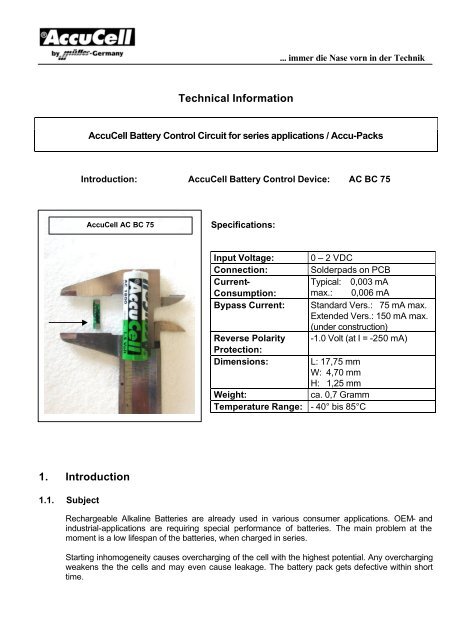Technical Information 1. Introduction - Accucell.de
Technical Information 1. Introduction - Accucell.de
Technical Information 1. Introduction - Accucell.de
You also want an ePaper? Increase the reach of your titles
YUMPU automatically turns print PDFs into web optimized ePapers that Google loves.
<strong>Technical</strong> <strong>Information</strong><br />
... immer die Nase vorn in <strong>de</strong>r Technik<br />
AccuCell Battery Control Circuit for series applications / Accu-Packs<br />
<strong>Introduction</strong>: AccuCell Battery Control Device: AC BC 75<br />
<strong>1.</strong> <strong>Introduction</strong><br />
<strong>1.</strong><strong>1.</strong> Subject<br />
AccuCell AC BC 75<br />
Specifications:<br />
Input Voltage: 0 – 2 VDC<br />
Connection: Sol<strong>de</strong>rpads on PCB<br />
Current-<br />
Typical: 0,003 mA<br />
Consumption: max.: 0,006 mA<br />
Bypass Current: Standard Vers.: 75 mA max.<br />
Exten<strong>de</strong>d Vers.: 150 mA max.<br />
(un<strong>de</strong>r construction)<br />
Reverse Polarity -<strong>1.</strong>0 Volt (at I = -250 mA)<br />
Protection:<br />
Dimensions: L: 17,75 mm<br />
W: 4,70 mm<br />
H: 1,25 mm<br />
Weight: ca. 0,7 Gramm<br />
Temperature Range: - 40° bis 85°C<br />
Rechargeable Alkaline Batteries are already used in various consumer applications. OEM- and<br />
industrial-applications are requiring special performance of batteries. The main problem at the<br />
moment is a low lifespan of the batteries, when charged in series.<br />
Starting inhomogeneity causes overcharging of the cell with the highest potential. Any overcharging<br />
weakens the the cells and may even cause leakage. The battery pack gets <strong>de</strong>fective within short<br />
time.
<strong>1.</strong>2. Target<br />
... immer die Nase vorn in <strong>de</strong>r Technik<br />
AccuCell has <strong>de</strong>veloped a special circuit, working as bypass, preventing the cell from overcharging<br />
when voltage clims up to voltage-level U1 during charging process.<br />
The ACBC75 <strong>de</strong>vice has to be installed in parallel to each cell of the pack. Power consumption of<br />
this circuit is very low, so that battery will not be discharged in “stand-by“mo<strong>de</strong> or even discharges<br />
the cell to a <strong>de</strong>stroying voltage level. To reach high accuracy voltage levels are trimmed within a 2%<br />
range. For optimal charging results an additional hysteresis is provi<strong>de</strong>d.<br />
2. <strong>Technical</strong> Datas<br />
2.<strong>1.</strong> How it works<br />
The ACBC 75 Protection Circuit bypasses the charging current as soon as voltage level reaches<br />
<strong>1.</strong>68 VDC (U1) as long as voltage level drops down to 1,6 VDC (U2). below level U2, circuit<br />
switches to “stand-by“ mo<strong>de</strong>, while consuming only some micro Amps (< 26 mAh / year ). The<br />
hysteresis ( U1 / U2 ) guarantees fully charged batteries.<br />
3. Advantages<br />
Longest lifespan due to preciselly controlled overcharging protection. Cells are homogenised during<br />
each charging cycle, that means same voltage level of every cell within the pack. Very low load of<br />
batteries during storage time: < 26 mAh per year.<br />
4. Applications<br />
Solar: Photovoltaic applications<br />
Industrial Appl.: Automotive, Measuring, Data-Systems, Control Engineering<br />
Data Proc. Systems: Handheld computer, Portable Systems<br />
Telecommunication: Cordless Phone, Handy, Pager<br />
Consumer Appl.: Audio, Vi<strong>de</strong>o, Games, Torche, etc.<br />
AccuCell Deutschland, ACBC75EN_TI9.99_BF
... immer die Nase vorn in <strong>de</strong>r Technik<br />
Please Note: All rights, also translations, reserved. Reproduction in any form whatsoever, wether photocopy,<br />
microfilm or entry in data processing equipment, with written approval of AccuCell-Deutschland only.<br />
Mistakes and printing errors reserved.


